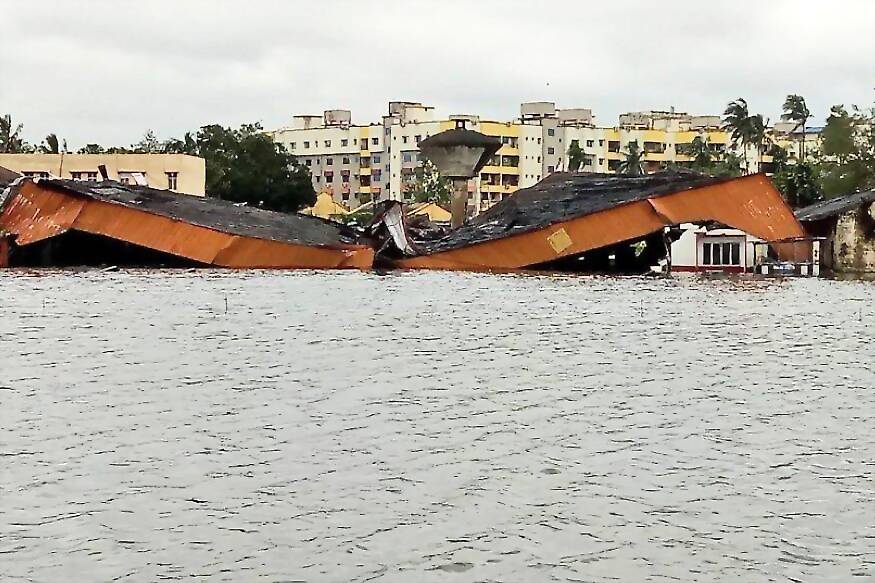Minimising Human Cost amid Mass Destruction: How NDRF Tackled Dual Test of Cyclone Amphan & Covid-19

views
As the Covid-19 crisis started unfolding in India in March, the National Disaster Response Force (NDRF) came up with a new training module to deal with calamities in times of the pandemic.
The preparation was meant to be for the approaching monsoons and the flooding season. Little did the force know that Amphan, the first super cyclone to form in the Bay of Bengal since the disaster of 1999, would challenge their training just a month later.
Amphan moved in with winds gusting up to over 200 km per hour, covering an area of over 600 kilometres and measuring 15 kilometres in height, before it hit land on Wednesday afternoon. By the time it hit the coast, it was gusting at about 160 kmph, slower but still whipping these states’ coastal regions with its fury and enough to be classified as an extremely severe cyclonic storm.
Such devastating speeds meant that a trail of destruction was a foregone conclusion. It was the human cost that was to be minimised.
The cyclone began by hitting the mangrove areas of Sundarbans before carving north and north-eastwards towards Kolkata. As many as 72 people in West Bengal have been confirmed dead so far, 15 of them in the state capital, and reports have not come in yet from all districts.
Thousands of trees were uprooted, electricity and telephone lines were brought down and houses were flattened or blown away. Many of Kolkata's roads are flooded and the city is without power.
Chief Minister Mamata Banerjee said she had never seen a disaster of this magnitude. “This has been the mother of all disasters,” she said, adding that the damage could have been much more severe.
What made relief efforts tougher this time was the added threat of coronavirus as people crammed into makeshift camps will increase the threat of infections.
Thankfully, India did not ignore the lessons from the 1999 super-cyclone that slammed Odisha and claimed nearly 10,000 lives. At the time, the state had failed to minimise the damage by wrongly predicting that two important cities, Bhubaneswar and Cuttack, wouldn't be affected by the storm. The shelter capacity was also limited to 75,000.
Accurate alert systems meant that 41 teams of NDRF with about 40 members in each had spread out to various parts of West Bengal and Odisha last week after the Indian Meteorological Department alerted for Cyclone Amphan.
The IMD advisory specifically mentioned structures that could be damaged and needed evacuation: it warned of total destruction of thatched houses, extensive damage to kutcha houses., potential threat from flying objects, major damage to kutcha and pucca roads, disruption of railways, overhead power lines and signalling system, bending or uprooting of power and communication poles.

Thousands of trees were uprooted, houses were flattened and roads were flooded due to the Cyclone. (Photo: News18)
Armed with the information, 21 NDRF teams in West Bengal and 20 in Odisha went around with state authorities to evacuate people. More than 5 lakh people were evacuated and taken to relief camps in West Bengal, while 2 lakh plus were evacuated in Odisha.
"Odisha has been repeatedly seeing cyclones. They saw Fani last year too. So Odiyas take state advisories by states more seriously. In West Bengal, we had to work a little extra to convince people to leave their homes and go to evacuation centres set up by the state government," NDRF’s DIG operational R Rana told News18.
But this time, there was a dual challenge, evacuation from Amphan and protection from coronavirus. The virus and social-distancing measures made mass evacuations more difficult, with shelters unable to be used to full capacity.
Schools, community centres and other government buildings had been turned into evacuation centres. In the epicentres of Sagar Island, Sundarbans and Kakdwip some villages had to be evacuated completely. Since a lot of these areas are islands or around riverine, work had to be done day and night to maintain social distancing in boats and yet evacuate all those who lived in structures marked dangerous.
"Normally 2.5 to 3 square meter per person is what we calculate while allotting evacuation homes. Because of coronavirus this time it had to be 6-7 square meter," the DIG operations said.
NDRF officials said IMD's timely and accurate warning made their job easier. Personnel on ground had time to repeatedly announce and sensitise villagers. Community leaders were roped in wherever villagers appeared reluctant to leave their homes.
NDRF personnel armed with PPE kits have now started helping states with restoration, a task that could take months as road connectivity has been snapped and power and communication lines have all been damaged.
The loss of life has been minimised by the evacuation, but loss of property is huge, especially in West Bengal. The NDRF says restoration will take time and the challenge is to keep Covid-19 away from the evacuation homes as people wait for their houses and their lives to be rebuilt.




















Comments
0 comment